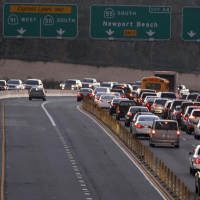Interstate 405 “Lexus Lanes” Hit a Speed Bump in Orange County
 The I-405 in Orange County (photo: Glenn Koenig, Los Angeles Times)
The I-405 in Orange County (photo: Glenn Koenig, Los Angeles Times)
Savvy urban planners probably know that they could solve metropolitan Los Angeles’ freeway gridlock if they could restrict the roads to rich people. But that’s pretty hard to do in a democracy with public roads that were built using taxpayer dollars.
The next best thing is converting part of the freeway to “Lexus lanes,” toll lanes that allow those drivers with the wherewithal to zip past their fellow motorists constrained by clogged traffic made all the more clogged by existence of the fast lane.
The Orange County Transportation Authority (OCTA) was poised last week to vote on a $1.47-billion project that could add the lanes to a 14-mile stretch of Interstate 405, but delayed a decision in the face of widespread community opposition. It’s one of three options available to the agency and the one favored by its staff. The project would add one regular lane and a toll lane on each side of the freeway, while also converting the existing carpool lanes to toll lanes.
Although the toll-lane proposal has generated a lot of controversy, the main hangup at the meeting Friday, according to the Los Angeles Times, appeared to be a lack of assurance from the California Department of Transportation (CalTrans) that OCTA would be allowed to control hours of operation and other cost policies, and retain excess revenues for itself.
Toll lanes were recently added to the 110 Harbor Freeway south of downtown Los Angeles and initial results were as expected. Drivers in the fast lanes went 10 mph faster and those in the slow lanes went 3.6-8 miles per hour slower. The toll lanes use “congestion pricing” that adjusts the cost of riding in them depending on how crowded the freeway is.
Drivers who buy a $40 transponder and pay a maintenance fee can drive in the lanes for 25 cents to $1.40 a mile, depending on traffic flow. Financially less fortunate folks may qualify for a $25 credit when they establish their accounts.
The Orange County transit agency estimates that northbound drivers would pay $9.91 during rush hour to traverse the entire 14 miles and $6.61 for the return trip. Assuming someone drove the route to work five days a week (and took a month off for vacation), the cost would be $3,964.80 a year.
Some critics consider that expense double-taxation to travel on a road built and maintained with taxpayer dollars. Others decry the trend toward substituting user fees for tax-based government solutions to community issues, and argue that problems won’t be addressed if we allow wealthier people to dodge them.
Supporters say the toll lanes take advantage of lanes that are otherwise underutilized, increase speeds for everyone, encourage mass-transit and raise the consciousness of all about the costs of driving.
The OCTA vote was put off until December.
–Ken Broder
To Learn More:
Vote on Controversial Orange County Toll Lanes Delayed (by Adolfo Flores, Los Angeles Times)
The Uprising Against O.C. Toll Lanes. Pt 1 (by Vern Nelson, The Orange Juice Blog)
Commentary: Stop the “South County Lexus” Lanes (by Eric Beaver, Daily Pilot commentary)
Solo Drivers in L.A. Who Can Afford Carpool Lanes Are Zipping Past Their Slower Brethren (by Ken Broder, AllGov California)
- Top Stories
- Controversies
- Where is the Money Going?
- California and the Nation
- Appointments and Resignations
- Unusual News
- Latest News
- California Forbids U.S. Immigration Agents from Pretending to be Police
- California Lawmakers Urged to Strip “Self-Dealing” Tax Board of Its Duties
- Big Oil’s Grip on California
- Santa Cruz Police See Homeland Security Betrayal in Use of Gang Roundup as Cover for Immigration Raid
- Oil Companies Face Deadline to Stop Polluting California Groundwater





